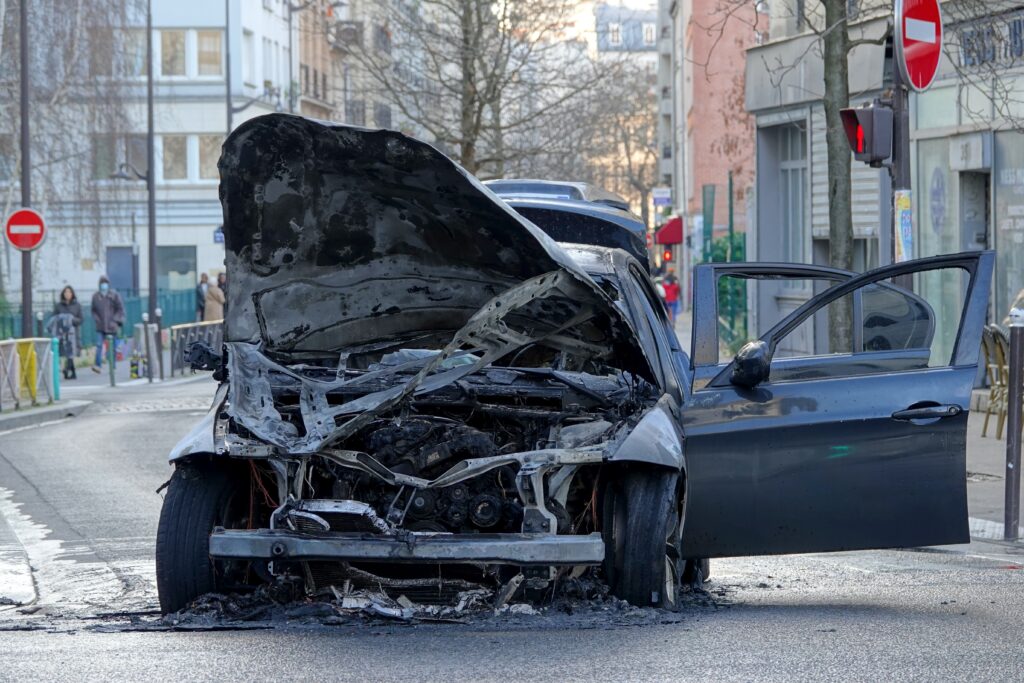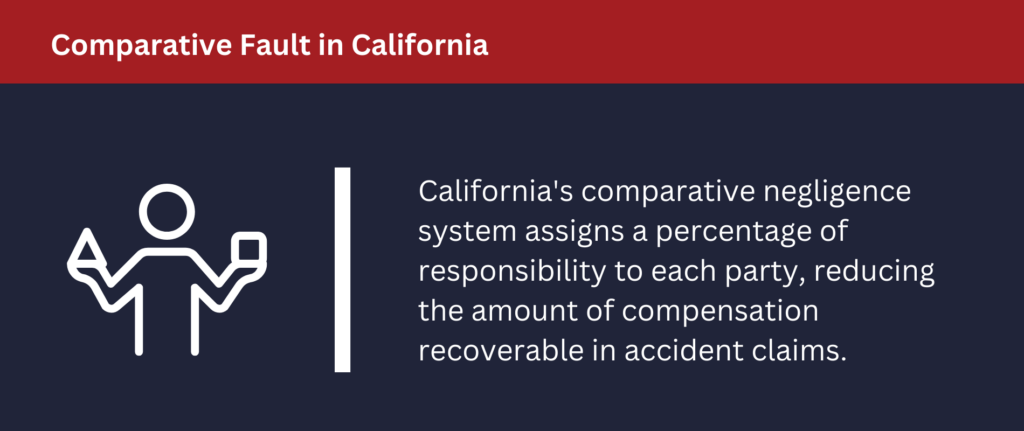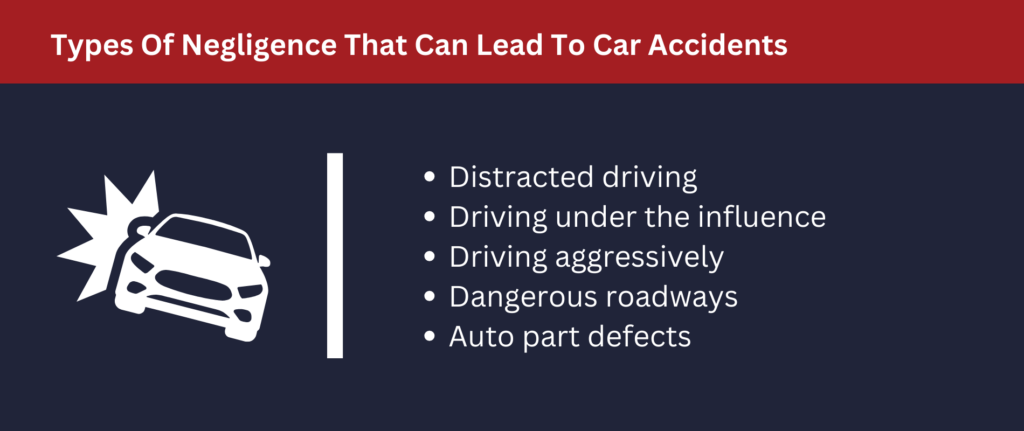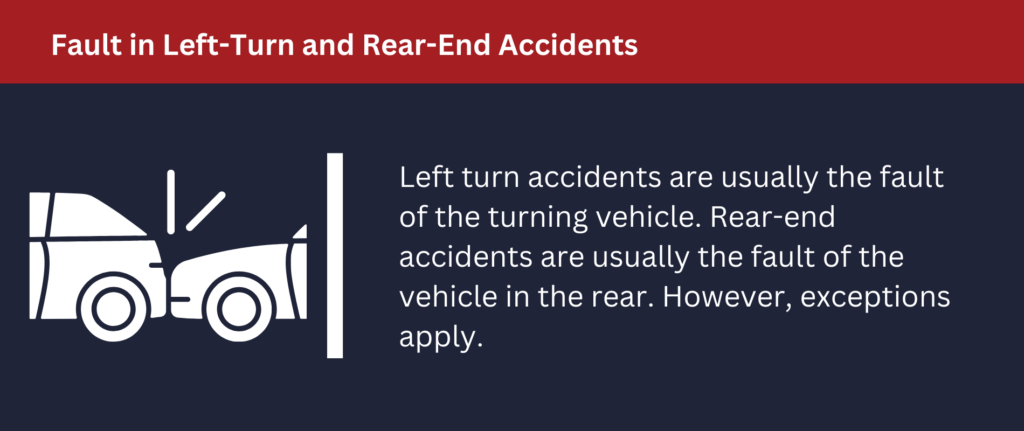
You can still receive compensation for your injuries if a car accident was partially your fault in California. California law simply reduces your compensation by your percentage of fault.
If you have been injured in an auto accident, the injury may be very painful and emotionally traumatic. You may be facing huge medical bills that you’re unable to pay because your injuries have left you unable to work. If you were partially to blame for your accident, you may be wondering if it’s pointless to seek help from a lawyer. It is not.
Experienced car accident lawyers like the ones at Nadrich Accident Injury Lawyers can help you recover financial compensation for your injuries, medical bills, pain, suffering, lost wages, and more—even if your car crash is ultimately determined to be partly your fault.
Furthermore, just because a police report says you are at fault or partly at fault for an accident doesn’t mean that a judge, jury, or insurance company will ultimately determine that you are at fault. Police reports are inadmissible in court, and their conclusions as to fault do not always end up being correct.
Comparative Fault in California

Negligence is the failure to be reasonably careful in the name of harm prevention. It is negligent to not do what a reasonably careful person would do under the same circumstances, and it is negligent to do what a reasonably careful person wouldn’t do under the same circumstances.
Drivers in California are considered at fault for an accident when it is determined that their negligence was a substantial factor in causing the accident. For example, a reasonably careful person would not text while driving, so someone who causes an accident by texting while driving is considered negligent and, thus, at fault for the accident.
California is a comparative negligence state. This means that multiple parties can be found partially responsible for an accident, and each party is ultimately assigned a percentage of responsibility for the accident.
The way this applies to compensation in an accident claim is this: if you have been injured in an accident that was partially your fault in California, the amount of money you can recover in a car accident claim is ultimately reduced by your percentage of fault.
So, if a court determines that you suffered $200,000 in compensable damages in a car accident that was 20 percent your fault, the damages you can recover are reduced by 20 percent of $200,000, or $40,000. You will be eligible for $160,000 in compensation in this case.
How Is Fault Determined in an Accident in California?
Since most accident claims are settled out of court, it is usually an insurance company that ultimately determines fault in an auto accident in California.
Different parties determine fault based on when it is determined who is at fault. Each insurance company involved in the claim will reach its own determination of fault based on any evidence they have. Insurance companies will often work with any drivers involved as well as the police.
When a party involved in the accident thinks a finding is incorrect, they can challenge the finding with a lawsuit. If the accident claim ultimately goes to trial, a jury or judge is ultimately responsible for determining fault.
Investigators with car accident experience can sometimes determine fault by where vehicles were damaged. As an example, most T-bone accidents are the fault of the driver whose vehicle sustained damage to the front of their vehicle.
Sometimes, physical evidence isn’t as important as other evidence, such as testimony from witnesses. Left-turn accidents can be an example of this. Drivers making left turns should typically yield. However, this conclusion can be changed by multiple factors, such as lights, driving while intoxicated, and speed.
Police Reports Can Be Helpful in Determining Fault

The police will not always arrive at an accident scene. The police will usually arrive at the scene of an accident in the case of severe collisions or collisions involving injuries. However, when accidents occur that barely damage vehicles, police dispatches will typically advise all parties to resolve their dispute by themselves through the exchange of information.
However, when the police do show up, their police report can be useful. Police reports summarize officers’ accident scene observations. The police will note many things, including:
- Any debris from vehicles on the road
- The positions of vehicles
- Vehicle damage
- Skid marks from tires
- Weather conditions
- Road conditions
The thing is, the police aren’t perfect. They are human, and humans make mistakes. Police reports can be important in terms of determining fault in an accident, but they are not always accurate. Because of this, it is possible to challenge them. You can even ask a police officer who filed a police report to change the report. They won’t always do so, but it’s worth trying if bad enough of a mistake was made.
Police reports can be quite useful in terms of figuring out what kind of investigation or evidence is necessary, but don’t rely completely on police reports. Police reports can simply point you in the right direction.
Determining Fault Is Determining Negligence
When parties try to determine fault in a car accident case, what they are really determining is who was negligent. Each car accident claim is centered on negligence, a legal concept.
Someone can be found financially liable for any losses you have incurred as a result of an accident when a court finds that they caused your accident by being negligent. Many different people can be found negligent in car accident claims, such as pedestrians, bicyclists, other drivers, government entities, or car manufacturers.
Negligence happens when people don’t behave as a reasonably careful person would in the same situation. For example, a reasonably careful person would not continue to drive if they found themselves dozing off while driving. If a driver continues to drive while drowsy and ends up causing an accident by falling asleep behind the wheel, they can be determined to be negligent and thus at fault for the auto accident.

There are multiple types of negligence that can lead to car accidents, including:
- Distracted driving: Examples of distracted driving include texting while driving, using a smartphone while driving, drinking or eating while driving, grooming yourself while driving, or dealing with children who are sitting in the back while driving. A reasonably careful person would not take their eyes off the road while driving, so distracted driving is negligent.
- Driving under the influence: A reasonably careful person would obviously not drive while under the influence of drugs or alcohol, so driving under the influence is negligent.
- Driving aggressively: It is obviously not acting in a reasonably careful manner when you engage in aggressive driving practices such as speeding, tailgating, or cutting off other cars, so aggressive driving can be negligent.
- Dangerous roadways: Sometimes, accidents aren’t any driver’s fault. Accidents can be caused by road hazards such as potholes, and a reasonably careful government entity wouldn’t allow dangerous potholes to persist in roadways. Government entities can sometimes be held liable for accidents due to their negligence.
- Auto part defects: Sometimes, accidents are the fault of a car manufacturer, as car malfunctions can cause accidents. It is common for defective tires or brakes to cause accidents, and a reasonably careful car manufacturer would adequately test parts to make sure they’re not defective, so selling defective vehicle parts can be negligent.
These are not the only examples of negligence that can cause car accidents. If you were partly to blame for an accident, but you’re able to provide enough evidence to prove that another party’s negligence also partly caused your accident, that party will be found partially liable for your injuries and any losses connected to them.
However, proving in a lawsuit that another party was negligent can be difficult, so it is important to be represented by experienced, expert lawyers like us if you want to do so.
Negligence Per Se
Another way of determining fault for an accident in California is negligence per se. This essentially means negligence by virtue of breaking the law. In other words, if a party is found to have violated the California Vehicle Code, and that violation is found to have contributed to the accident, that party is considered to be negligent by virtue of breaking the vehicle code.
Being able to prove that another driver violated the vehicle code and that this caused your accident can give you tons of leverage in terms of proving who is at fault for causing your car accident injuries.
Fault in Left-Turn and Rear-End Accidents
Left-turn and rear-end accidents are two of the easiest types of accidents to prove. When cars turning left hit vehicles who are traveling straight through intersections, the accidents are almost always the fault of the car that turns left, since cars going straight through intersections typically have the right of way.

Cars that turn left typically need to yield to any oncoming traffic. However, blame can shift when cars going straight run a stop sign or a red light, or are speeding.
The driver at the back is almost always at fault for a rear-end accident. If somebody recklessly turns their car in front of your vehicle and then brakes suddenly, causing you to rear-end them, it is possible for you to prove that the accident was their fault. However, to do so, you will need extremely strong testimony from a witness or, ideally, video evidence.
Evidence at the Scene Can Help Determine Fault
Accident scenes can be helpful in terms of determining fault. Things that can help prove fault include road geography and debris.
It’s helpful to take as many pictures as you can of any vehicle damage, vehicle positions, and any roads involved after an accident. Things like weather conditions, parts of cars, skid marks, and vehicle debris like broken glass are good things to take pictures of.
Photos of vehicle damage can be helpful for any experts your lawyer hires in terms of reconstructing an accident.
A Good Lawyer Is Your Best Tool in Proving Fault

If you were partially at fault for an accident, the best way for you to receive as much compensation as possible for your injuries is to prove that another party was also at fault for your accident and that that party’s percentage of fault for the accident is as high as possible.
Experienced personal injury lawyers like those with Nadrich Accident Injury Lawyers can help with this. We deal with countless accident cases every month, just like any insurance adjusters you will face in an accident claim. We make a living by proving that other drivers were at fault for our clients’ injuries.
Even if you can prove another party was at fault for your accident, insurance companies still won’t pay you what you deserve for your injuries if you don’t have a lawyer. They know you can’t beat them in court without a lawyer. And they know that if they offer you a tiny settlement, your only options are to accept it or take them to court over it—where you’ll lose without a lawyer.
However, merely hiring an attorney often convinces insurance adjusters to suddenly offer you what you deserved all along for your injuries, especially when you hire lawyers with a long track record of success like we do. Most of our cases settle out of court because insurance companies know it’s a waste of time and money to go up against us in court—where they’ll almost certainly lose.
Contact a Car Accident Lawyer at Nadrich Accident Injury Lawyers Today
Call us today, text us from this page, or contact us online for a free consultation if you or a loved one was injured in an auto accident, even if the accident was partially your fault. You may still be entitled to financial compensation.
The only fee we charge is a percentage of any financial recovery obtained, and we don’t charge any fee if we don’t obtain a financial recovery for you. You won’t be charged unless and until we obtain compensation for you. The insurance companies won’t offer you a fair settlement for your injuries unless you’re represented by a lawyer, so don’t hesitate to call us now.

